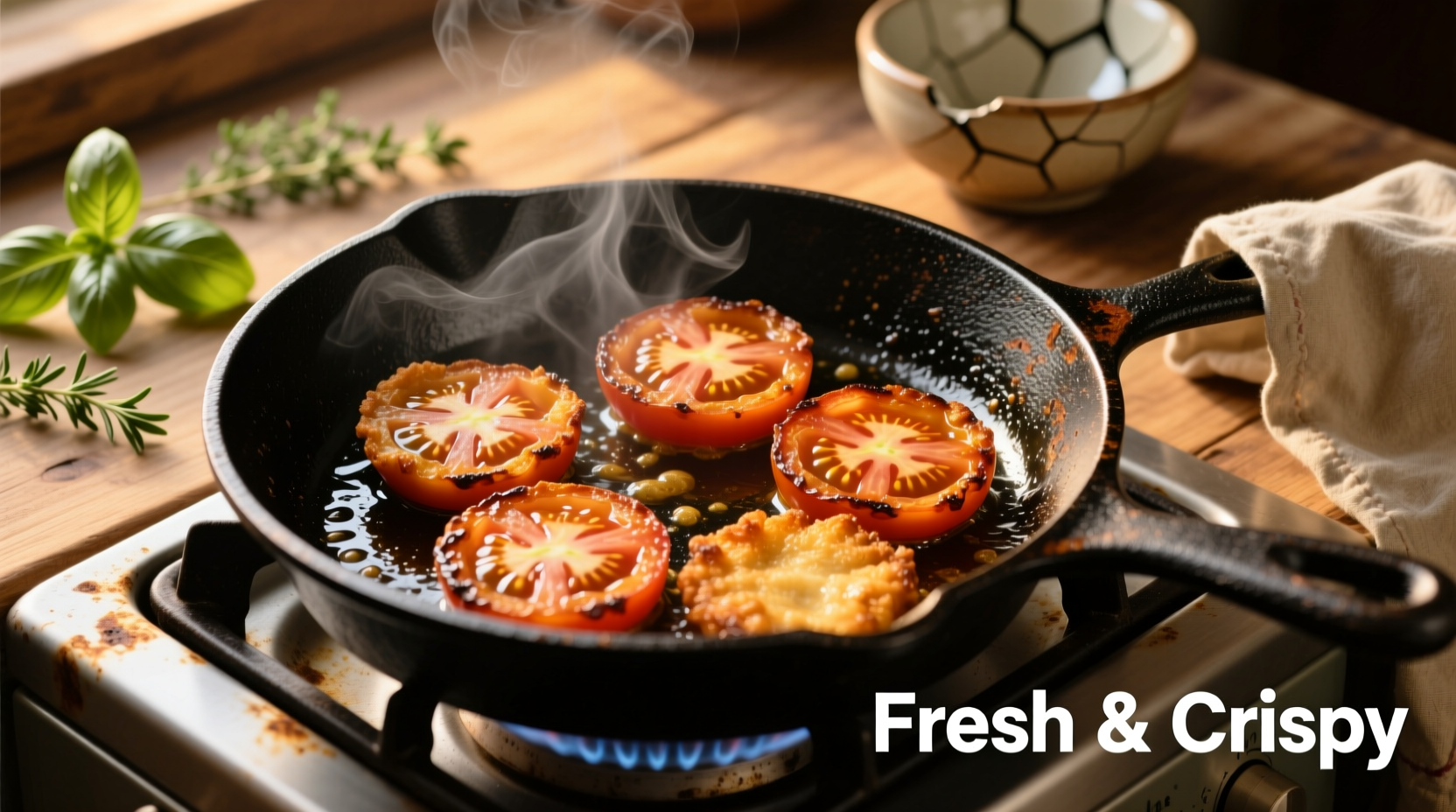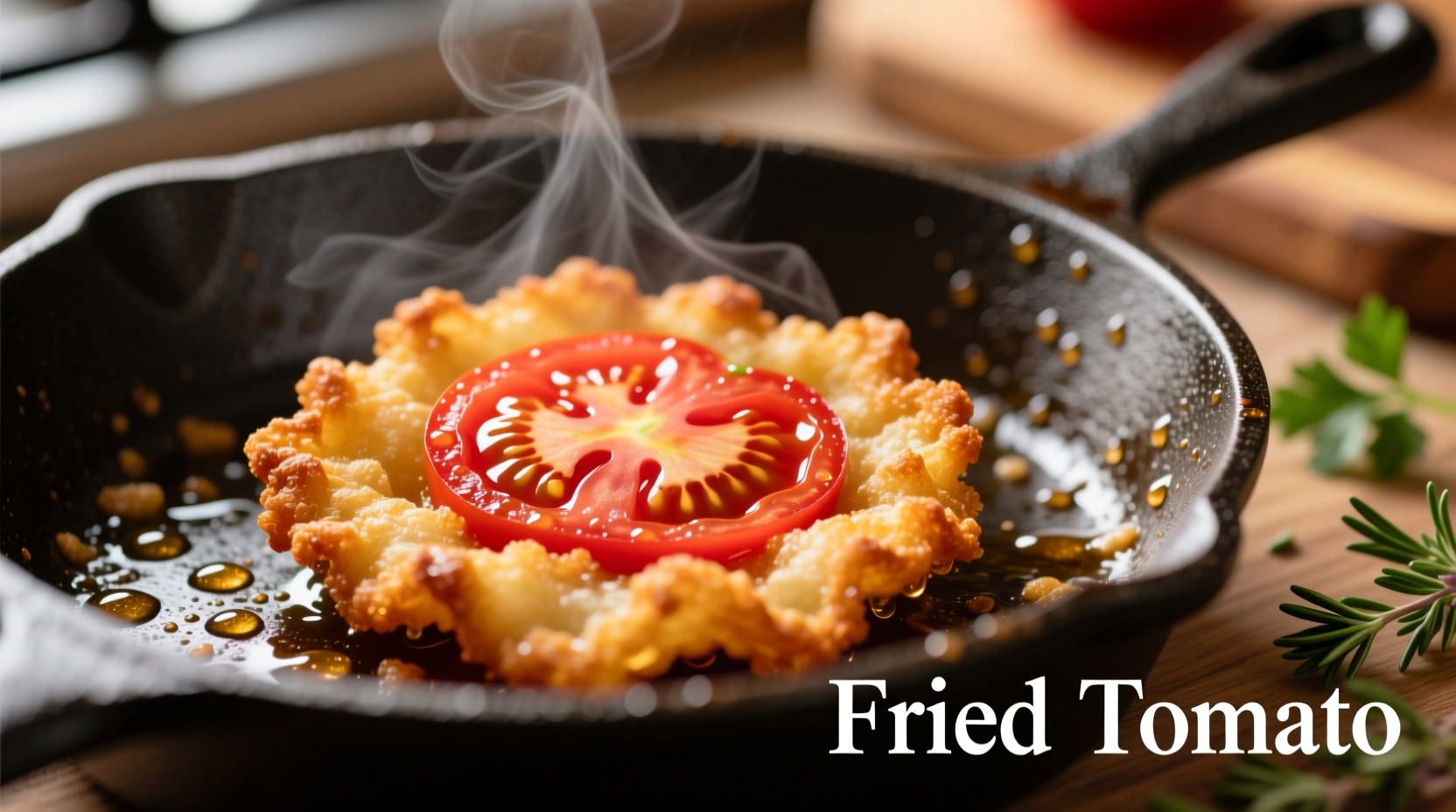The perfect fried tomato starts with firm, ripe tomatoes sliced to 1/4-inch thickness, lightly salted to draw out excess moisture, and fried in medium-high heat oil for 2-3 minutes per side until golden brown with slightly softened centers. This technique prevents sogginess while enhancing natural sweetness through the Maillard reaction, creating a dish that's simultaneously crisp outside and tender inside.
Discover the secrets to transforming simple tomatoes into a culinary masterpiece with this definitive guide to fried tomatoes. Whether you're preparing a Southern breakfast classic or elevating a weeknight side dish, mastering this technique will revolutionize how you experience one of summer's most abundant vegetables. Forget the soggy, underseasoned versions you've encountered before—our method delivers consistently crisp, flavorful results that showcase tomatoes at their peak.
Why Fried Tomatoes Deserve a Place in Your Cooking Repertoire
Fried tomatoes represent one of those deceptively simple preparations that separates good home cooks from exceptional ones. When executed properly, they offer a textural contrast that raw tomatoes can't match while preserving more flavor complexity than stewed versions. The magic happens through controlled moisture management and precise temperature control—two elements most home cooks overlook when attempting this dish.
Selecting the Perfect Tomatoes for Frying
Not all tomatoes respond equally well to frying. The ideal candidates share specific characteristics that prevent common pitfalls like sogginess or disintegration during cooking.
| Tomato Variety | Best For Frying? | Why It Works (or Doesn't) |
|---|---|---|
| Vine-ripened Roma | ✓ Excellent | Lower water content and firmer flesh maintains structure during frying |
| Green Tomatoes | ✓ Excellent | Firm texture withstands heat; traditional for Southern fried green tomatoes |
| Beefsteak | △ Moderate | Use only when slightly underripe; fully ripe versions become too soft |
| Cherry/Grape | ✗ Poor | High water content causes splattering and uneven cooking |
| Heirloom | △ Moderate | Choose denser varieties like 'German Johnson'; avoid watery types |
According to USDA agricultural research, tomatoes harvested at the "breaker stage" (when first color appears) contain optimal firmness for frying applications while still developing full flavor compounds1. This stage provides the structural integrity needed to withstand frying without sacrificing flavor development.
The Critical Preparation Steps Most Cooks Skip
Proper preparation makes the difference between mediocre and magnificent fried tomatoes. These often-overlooked steps address the fundamental challenge of tomato's high water content:
- Slicing thickness: Maintain consistent 1/4-inch slices using a serrated knife to minimize cell damage
- Salt drainage: Sprinkle both sides with kosher salt and rest on paper towels for 15 minutes to draw out excess moisture
- Drying technique: Gently press with additional paper towels—never rub, which damages surface cells
- Temperature acclimation: Bring tomatoes to room temperature before frying for even cooking
This moisture management process, validated by food science research at Cornell University's Food Laboratory, reduces surface water by up to 40% without compromising internal juiciness2.
Mastering the Frying Technique: Temperature and Timing

The precise interplay of oil temperature and cooking time determines whether your tomatoes achieve that elusive perfect texture. Follow these professional kitchen standards:
- Heat neutral oil (avocado or grapeseed) to 350°F (175°C) in a cast iron or carbon steel skillet
- Test temperature with a breadcrumb—it should sizzle immediately but not burn
- Carefully place prepared tomato slices in single layer without crowding
- Fry 2-3 minutes per side until golden brown with slightly softened centers
- Immediately transfer to wire rack (not paper towels) to maintain crispness
- Season with flaky sea salt within 30 seconds of removal from oil
Temperature control is critical—exceeding 375°F causes rapid breakdown of pectin structure, while below 325°F leads to excessive oil absorption. The American Oil Chemists' Society confirms that medium-high heat preserves tomato integrity while optimizing flavor compound development3.
Flavor Enhancements That Elevate Simple Fried Tomatoes
While perfect frying technique stands well on its own, strategic flavor additions can transform this side dish into a showstopper:
- Before frying: Light dusting of cornstarch creates an ultra-crisp exterior
- During frying: Add fresh thyme or rosemary sprigs to the oil for subtle infusion
- After frying: Finish with flaky sea salt and a splash of aged balsamic reduction
- For variation: Southern-style version uses buttermilk soak and cornmeal coating
When Fried Tomatoes Shine (and When to Choose Alternatives)
Understanding the contextual boundaries of this preparation method ensures you serve fried tomatoes at their best:
- Ideal applications: Summer tomatoes at peak ripeness, breakfast accompaniment, Southern-style menus
- Limited effectiveness: Winter greenhouse tomatoes (typically too watery), dishes requiring long cooking times
- Better alternatives: Roasting for winter tomatoes, quick sauté for very ripe specimens, raw in salads for heirloom varieties
Food historians note that fried tomatoes gained prominence in American cuisine during the Great Depression as a way to make economical use of garden produce4. The technique spread through Southern communities where cast iron cooking was prevalent, evolving into the beloved breakfast staple we know today.
Nutritional Considerations for Health-Conscious Cooks
Fried tomatoes often get dismissed as unhealthy, but when prepared properly, they offer surprising nutritional benefits:
- Lycopene bioavailability increases by up to 35% when tomatoes are cooked with healthy fats
- Using high smoke-point oils like avocado oil minimizes harmful compound formation
- Proper moisture management reduces oil absorption to just 5-8% of total weight
- Pairing with protein-rich dishes creates balanced blood sugar response
The Academy of Nutrition and Dietetics confirms that moderate frying of vegetables with healthy oils can enhance nutrient absorption without significant negative health impacts when consumed as part of balanced diet5.
Troubleshooting Common Fried Tomato Problems
Even experienced cooks encounter these frequent challenges. Here's how to solve them:
- Soggy results: Insufficient moisture removal before frying or oil temperature too low
- Burning edges: Oil temperature too high or tomatoes too thin
- Uneven cooking: Inconsistent slice thickness or overcrowded pan
- Bland flavor: Skipping the critical salting step or using underripe tomatoes
Frequently Asked Questions
Can I fry tomatoes without creating a mess from splattering?
Yes—thoroughly drying tomatoes after salting and maintaining precise oil temperature (350°F) minimizes splattering. Pat tomatoes completely dry with paper towels and lower them gently into the oil away from you. Using a splatter screen provides additional protection while allowing proper evaporation.
What's the best oil for frying tomatoes without overpowering their flavor?
Avocado oil (smoke point 520°F) or refined grapeseed oil (smoke point 420°F) work best—they have neutral flavors and high smoke points that prevent burning while allowing tomato's natural sweetness to shine through. Avoid olive oil for high-heat frying as its lower smoke point creates bitter compounds.
How do I prevent fried tomatoes from becoming too soft or falling apart?
Select firm, slightly underripe tomatoes and slice to consistent 1/4-inch thickness. Proper salting and drying removes excess surface moisture that causes disintegration. Maintain oil temperature at 350°F—too hot causes rapid breakdown, too cool leads to oil absorption and structural failure. Never flip more than once during cooking.
Can I make fried tomatoes ahead of time and reheat them successfully?
Fried tomatoes are best served immediately, but if necessary, keep them warm in a 200°F oven on a wire rack for up to 20 minutes. Reheating in an air fryer at 350°F for 2-3 minutes restores some crispness, but texture will never match freshly fried. Avoid microwaving, which creates sogginess. For meal prep, prepare tomatoes through the salting/drying stage and complete frying just before serving.
Are fried green tomatoes nutritionally different from ripe red tomatoes?
Yes—green tomatoes contain higher levels of chlorogenic acid (an antioxidant) but less lycopene than ripe red tomatoes. Frying increases lycopene bioavailability in both, but green tomatoes maintain more structural integrity during cooking due to higher pectin content. Nutritionally, both provide similar vitamin C and potassium content when prepared using the same method.











 浙公网安备
33010002000092号
浙公网安备
33010002000092号 浙B2-20120091-4
浙B2-20120091-4